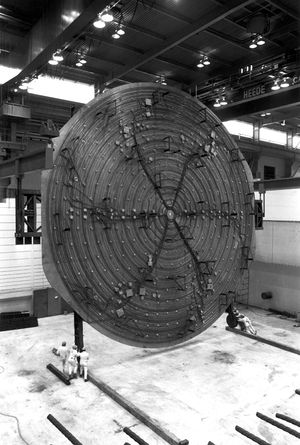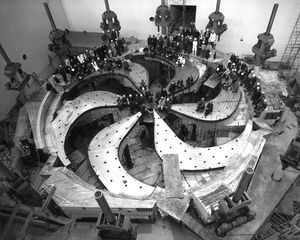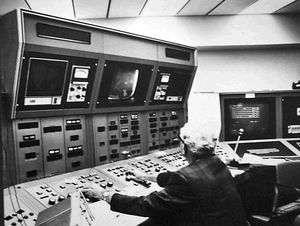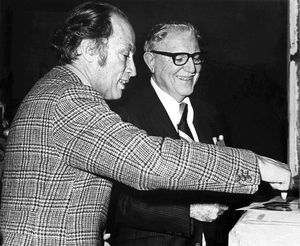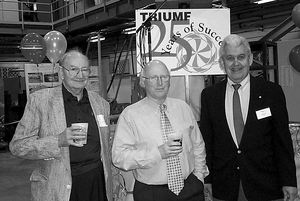Milestone-Nomination:First 500 MeV proton beam from the worlds largest cyclotron: Difference between revisions
Dmichelson (talk | contribs) No edit summary |
Dmichelson (talk | contribs) No edit summary |
||
| Line 4: | Line 4: | ||
= '''Proposed Citation = | = '''Proposed Citation''' = | ||
'''At 3:30 pm on 15 December 1974, the first 500 MeV proton beam was extracted from the TRIUMF cyclotron. Since then, TRIUMF has used proton beams from its cyclotron (and secondary muon and pion beams produced in its experimental halls) to conduct pioneering studies that have advanced nuclear physics, particle physics, molecular and materials science, and nuclear medicine.<br><br><span class="Apple-style-span" style="font-weight: normal;">The plaque will be installed outside the cyclotron main control room near the site dedication plaque. (The first successful beam extraction was manually controlled from the main console in that room.)</span><br><br>''' | '''First 500 MeV Proton Beam from the World's Largest Cyclotron, 1974''' | ||
'''At 3:30 pm on 15 December 1974, the first 500 MeV proton beam was extracted from the TRIUMF cyclotron. Since then, TRIUMF has used proton beams from its cyclotron (and secondary muon and pion beams produced in its experimental halls) to conduct pioneering studies that have advanced nuclear physics, particle physics, molecular and materials science, and nuclear medicine.<br><br><span class="Apple-style-span" style="font-weight: normal;">The plaque will be installed outside the cyclotron main control room near the site dedication plaque. (The first successful beam extraction was manually controlled from the main console in that room.)</span><br><br>''' | |||
=== '''<br>Historic Photographs''' === | === '''<br>Historic Photographs''' === | ||
| Line 16: | Line 17: | ||
'''[[Image:CL-11-sitting down.jpg|thumb|center|January 1972: TRIUMF staff gather on the lower six sectors of the cyclotron magnet.]]<br> [[Image:CL26 500Mev.jpg|thumb|center|December 1974: Director Dr. J. R. Richardson tunes the proton beam to the design energy of 500 Mev]]''' | '''[[Image:CL-11-sitting down.jpg|thumb|center|January 1972: TRIUMF staff gather on the lower six sectors of the cyclotron magnet.]]<br> [[Image:CL26 500Mev.jpg|thumb|center|December 1974: Director Dr. J. R. Richardson tunes the proton beam to the design energy of 500 Mev]]''' | ||
'''[[Image:CL-5-pierre trudeau.jpg|thumb|center|February 1976: Prime Minister Trudeau visits TRIUMF. "I don't really know what a cyclotron is but I am certainly very happy Canada has one!"]][[Image:CL25-silver anniversary.jpg|thumb|center|December 1999: The Silver Anniversary celebration of the first extraction of a full energy proton beam from the TRIUMF cyclotron. Pictured are TRIUMF Directors from left, Dr. Jack Sample, Dr. Alan Astbury, and Dr. Erich Vogt.]]<br><br>''Please also include references and full citations, and include supporting material in an electronic format (GIF, JPEG, PNG, PDF, DOC) which can be made available on the IEEE History Center’s Web site to historians, scholars, students, and interested members of the public. All supporting materials must be in English, or if not in English, accompanied by an English translation. If you are including images or photographs as part of the supporting material, it is necessary that you list the copyright owner.''''' | '''[[Image:CL-5-pierre trudeau.jpg|thumb|center|February 1976: Prime Minister Trudeau visits TRIUMF. "I don't really know what a cyclotron is but I am certainly very happy Canada has one!"]][[Image:CL25-silver anniversary.jpg|thumb|center|December 1999: The Silver Anniversary celebration of the first extraction of a full energy proton beam from the TRIUMF cyclotron. Pictured are TRIUMF Directors from left, Dr. Jack Sample, Dr. Alan Astbury, and Dr. Erich Vogt.]]<br><br>''Please also include references and full citations, and include supporting material in an electronic format (GIF, JPEG, PNG, PDF, DOC) which can be made available on the IEEE History Center’s Web site to historians, scholars, students, and interested members of the public. All supporting materials must be in English, or if not in English, accompanied by an English translation. If you are including images or photographs as part of the supporting material, it is necessary that you list the copyright owner.''''' | ||
== In the space below the line, please describe the historic significance of this work: its importance to the evolution of electrical and computer engineering and science and its importance to regional/national/international development. == | == In the space below the line, please describe the historic significance of this work: its importance to the evolution of electrical and computer engineering and science and its importance to regional/national/international development. == | ||
<br>The TRIUMF cyclotron was designed, constructed and commissioned between 1969 and 1974. The facility has operated continuously, and has expanded several times, since then. | <br>The TRIUMF cyclotron was designed, constructed and commissioned between 1969 and 1974. The facility has operated continuously, and has expanded several times, since then. | ||
By providing intermediate energy proton beams that are two orders of magnitude more intense than were previously available, the TRIUMF cyclotron (and its two sister meson factories in the United States and Europe) have revolutionized nuclear physics, particle physics, molecular and materials science, and nuclear medicine. | By providing intermediate energy proton beams that are two orders of magnitude more intense than were previously available, the TRIUMF cyclotron (and its two sister meson factories in the United States and Europe) have revolutionized nuclear physics, particle physics, molecular and materials science, and nuclear medicine. | ||
Compared to the first and second generation of cyclotrons, the physical size of TRIUMF is truly impressive. The main magnet is 18 metres in diameter and weighs 4000 tons. The 23 MHz main RF amplifier delivers almost 1 million watts of power in order to develop 200 kV across the accelerating gap. | Compared to the first and second generation of cyclotrons, the physical size of TRIUMF is truly impressive. The main magnet is 18 metres in diameter and weighs 4000 tons. The 23 MHz main RF amplifier delivers almost 1 million watts of power in order to develop 200 kV across the accelerating gap. | ||
During the design and construction of the cyclotron between 1969 and 1974, the sheer scale of the effort required TRIUMF staff and contractors to develop revolutionary computer-assisted design, modelling, measurement and tuning technologies in an era dominated by mainframes and minicomputers. Some of these codes, e.g., RELAX3D - a Laplace and Poisson equation solver, are still in use today. | During the design and construction of the cyclotron between 1969 and 1974, the sheer scale of the effort required TRIUMF staff and contractors to develop revolutionary computer-assisted design, modelling, measurement and tuning technologies in an era dominated by mainframes and minicomputers. Some of these codes, e.g., RELAX3D - a Laplace and Poisson equation solver, are still in use today. | ||
Because of its size, TRIUMF was one of the first particle accelerators to employ a software-based supervisory control and data acquisition system rather than direct linkage of cyclotron and beamline components to a hardware-based control panel. | Because of its size, TRIUMF was one of the first particle accelerators to employ a software-based supervisory control and data acquisition system rather than direct linkage of cyclotron and beamline components to a hardware-based control panel. | ||
The quality of the initial design and engineering and the significance of the result are underscored by the longevity of the TRIUMF cyclotron. Thirty-five years after the first 500 MeV proton beam was extracted, the cyclotron is still the main engine of TRIUMF’s world-leading research program which currently includes meson physics, nuclear physics, nuclear astrophysics, nuclear medicine and irradiation services for industry.<br> | The quality of the initial design and engineering and the significance of the result are underscored by the longevity of the TRIUMF cyclotron. Thirty-five years after the first 500 MeV proton beam was extracted, the cyclotron is still the main engine of TRIUMF’s world-leading research program which currently includes meson physics, nuclear physics, nuclear astrophysics, nuclear medicine and irradiation services for industry.<br> | ||
== What features or characteristics set this work apart from similar achievements? == | == What features or characteristics set this work apart from similar achievements? == | ||
TRIUMF is the world's largest cyclotron, and one of only three intermediate-energy high-intensity accelerators in the world. It pioneered the production and acceleration of H- ions and the use of an AVF (azimuthally varying field) main magnet. | TRIUMF is the world's largest cyclotron, and one of only three intermediate-energy high-intensity accelerators in the world. It pioneered the production and acceleration of H- ions and the use of an AVF (azimuthally varying field) main magnet. | ||
Unlike the world's other two intermediate-energy high-intensity accelerators (located near Zurich and Los Alamos, respectively), the TRIUMF cyclotron can deliver both low-intensity variable energy proton beams and high intensity intermediate energy proton beams with a 100% macroscopic duty cycle. | Unlike the world's other two intermediate-energy high-intensity accelerators (located near Zurich and Los Alamos, respectively), the TRIUMF cyclotron can deliver both low-intensity variable energy proton beams and high intensity intermediate energy proton beams with a 100% macroscopic duty cycle. | ||
The high intensity of the beam also allows the cyclotron to serve as the driver for multiple experiments within the course of a week. The TRIUMF cyclotron’s ability to provide steady, intense and reliable energy beams in a flexible manner has also allowed the facility to become a world leader in providing beams of exotic isotopes using the "isotope separation online" technique. <br> | The high intensity of the beam also allows the cyclotron to serve as the driver for multiple experiments within the course of a week. The TRIUMF cyclotron’s ability to provide steady, intense and reliable energy beams in a flexible manner has also allowed the facility to become a world leader in providing beams of exotic isotopes using the "isotope separation online" technique. <br> | ||
== Please attach a letter in English, or with English translation, from the site owner giving permission to place IEEE milestone plaque on the property. == | == Please attach a letter in English, or with English translation, from the site owner giving permission to place IEEE milestone plaque on the property. == | ||
''The letter is necessary in order to process your nomination form. Click the Attachments tab to upload your letter.'' <br><br>[[Media:IEEE-Milestone-Support-TRIUMF.pdf|IEEE-Milestone-Support-TRIUMF.pdf]]<br | ''The letter is necessary in order to process your nomination form. Click the Attachments tab to upload your letter.'' <br><br>[[Media:IEEE-Milestone-Support-TRIUMF.pdf|IEEE-Milestone-Support-TRIUMF.pdf]]<br>[[Media:CL9-vacuum.jpg|CL9-vacuum.jpg]]<br>[[Media:CL-11-sitting_down.jpg|CL-11-sitting_down.jpg]]<br>[[Media:CL26_500Mev.jpg|CL26_500Mev.jpg]]<br>[[Media:CL-5-pierre_trudeau.jpg|CL-5-pierre_trudeau.jpg]]<br>[[Media:CL25-silver_anniversary.jpg|CL25-silver_anniversary.jpg]] | ||
Revision as of 04:26, 9 January 2010
Docket Number: 2009-08
Proposal Link: https://ethw.org/Milestone-Proposal:First_500_MeV_proton_beam_from_the_worlds_largest_cyclotron
Proposed Citation
First 500 MeV Proton Beam from the World's Largest Cyclotron, 1974
At 3:30 pm on 15 December 1974, the first 500 MeV proton beam was extracted from the TRIUMF cyclotron. Since then, TRIUMF has used proton beams from its cyclotron (and secondary muon and pion beams produced in its experimental halls) to conduct pioneering studies that have advanced nuclear physics, particle physics, molecular and materials science, and nuclear medicine.
The plaque will be installed outside the cyclotron main control room near the site dedication plaque. (The first successful beam extraction was manually controlled from the main console in that room.)
Historic Photographs
Please also include references and full citations, and include supporting material in an electronic format (GIF, JPEG, PNG, PDF, DOC) which can be made available on the IEEE History Center’s Web site to historians, scholars, students, and interested members of the public. All supporting materials must be in English, or if not in English, accompanied by an English translation. If you are including images or photographs as part of the supporting material, it is necessary that you list the copyright owner.
In the space below the line, please describe the historic significance of this work: its importance to the evolution of electrical and computer engineering and science and its importance to regional/national/international development.
The TRIUMF cyclotron was designed, constructed and commissioned between 1969 and 1974. The facility has operated continuously, and has expanded several times, since then.
By providing intermediate energy proton beams that are two orders of magnitude more intense than were previously available, the TRIUMF cyclotron (and its two sister meson factories in the United States and Europe) have revolutionized nuclear physics, particle physics, molecular and materials science, and nuclear medicine.
Compared to the first and second generation of cyclotrons, the physical size of TRIUMF is truly impressive. The main magnet is 18 metres in diameter and weighs 4000 tons. The 23 MHz main RF amplifier delivers almost 1 million watts of power in order to develop 200 kV across the accelerating gap.
During the design and construction of the cyclotron between 1969 and 1974, the sheer scale of the effort required TRIUMF staff and contractors to develop revolutionary computer-assisted design, modelling, measurement and tuning technologies in an era dominated by mainframes and minicomputers. Some of these codes, e.g., RELAX3D - a Laplace and Poisson equation solver, are still in use today.
Because of its size, TRIUMF was one of the first particle accelerators to employ a software-based supervisory control and data acquisition system rather than direct linkage of cyclotron and beamline components to a hardware-based control panel.
The quality of the initial design and engineering and the significance of the result are underscored by the longevity of the TRIUMF cyclotron. Thirty-five years after the first 500 MeV proton beam was extracted, the cyclotron is still the main engine of TRIUMF’s world-leading research program which currently includes meson physics, nuclear physics, nuclear astrophysics, nuclear medicine and irradiation services for industry.
What features or characteristics set this work apart from similar achievements?
TRIUMF is the world's largest cyclotron, and one of only three intermediate-energy high-intensity accelerators in the world. It pioneered the production and acceleration of H- ions and the use of an AVF (azimuthally varying field) main magnet.
Unlike the world's other two intermediate-energy high-intensity accelerators (located near Zurich and Los Alamos, respectively), the TRIUMF cyclotron can deliver both low-intensity variable energy proton beams and high intensity intermediate energy proton beams with a 100% macroscopic duty cycle.
The high intensity of the beam also allows the cyclotron to serve as the driver for multiple experiments within the course of a week. The TRIUMF cyclotron’s ability to provide steady, intense and reliable energy beams in a flexible manner has also allowed the facility to become a world leader in providing beams of exotic isotopes using the "isotope separation online" technique.
Please attach a letter in English, or with English translation, from the site owner giving permission to place IEEE milestone plaque on the property.
The letter is necessary in order to process your nomination form. Click the Attachments tab to upload your letter.
IEEE-Milestone-Support-TRIUMF.pdf
CL9-vacuum.jpg
CL-11-sitting_down.jpg
CL26_500Mev.jpg
CL-5-pierre_trudeau.jpg
CL25-silver_anniversary.jpg
